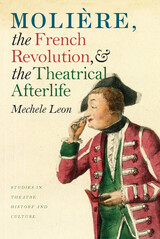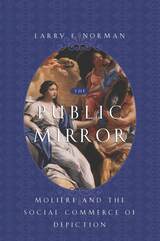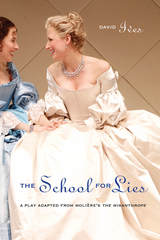3 books about 1622-1673

Molière, the French Revolution, and the Theatrical Afterlife
Leon, Mechele
University of Iowa Press, 2009
From 1680 until the French Revolution, when legislation abolished restrictions on theatrical enterprise, a single theatre held sole proprietorship of Molière’s works. After 1791, his plays were performed in new theatres all over Paris by new actors, before audiences new to his works. Both his plays and his image took on new dimensions. In Molière, the French Revolution, and the Theatrical Afterlife, Mechele Leon convincingly demonstrates how revolutionaries challenged the ties that bound this preeminent seventeenth-century comic playwright to the Old Regime and provided him with a place of honor in the nation’s new cultural memory.
Leon begins by analyzing the performance of Molière’s plays during the Revolution, showing how his privileged position as royal servant was disrupted by the practical conditions of the revolutionary theatre. Next she explores Molière’s relationship to Louis XIV, Tartuffe, and the social function of his comedy, using Rousseau’s famous critique of Molière as well as appropriations of George Dandin in revolutionary iconography to discuss how Moliérean laughter was retooled to serve republican interests. After examining the profusion of plays dealing with his life in the latter years of the Revolution, she looks at the exhumation of his remains and their reentombment as the tangible manifestation of his passage from Ancien Régime favorite to new national icon.
The great Molière is appreciated by theatre artists and audiences worldwide, but for the French people it is no exaggeration to say that the Father of French Comedy is part of their national soul. By showing how he was represented, reborn, and reburied in the new France—how the revolutionaries asserted his relevance for their tumultuous time in ways that were audacious, irreverent, imaginative, and extreme—Leon clarifies the important role of theatrical figures in preserving and portraying a nation’s history.
Leon begins by analyzing the performance of Molière’s plays during the Revolution, showing how his privileged position as royal servant was disrupted by the practical conditions of the revolutionary theatre. Next she explores Molière’s relationship to Louis XIV, Tartuffe, and the social function of his comedy, using Rousseau’s famous critique of Molière as well as appropriations of George Dandin in revolutionary iconography to discuss how Moliérean laughter was retooled to serve republican interests. After examining the profusion of plays dealing with his life in the latter years of the Revolution, she looks at the exhumation of his remains and their reentombment as the tangible manifestation of his passage from Ancien Régime favorite to new national icon.
The great Molière is appreciated by theatre artists and audiences worldwide, but for the French people it is no exaggeration to say that the Father of French Comedy is part of their national soul. By showing how he was represented, reborn, and reburied in the new France—how the revolutionaries asserted his relevance for their tumultuous time in ways that were audacious, irreverent, imaginative, and extreme—Leon clarifies the important role of theatrical figures in preserving and portraying a nation’s history.
[more]

The Public Mirror
Moliere and the Social Commerce of Depiction
Larry F. Norman
University of Chicago Press, 1999
Though much beloved and widely produced, Molière's satirical comedies pose a problem for those reading or staging his works today: how can a genre associated with biting caricature and castigation deliver engaging theater? Instead of simply dismissing social satire as a foundation for Molière's theater, as many have done, Larry F. Norman takes seriously Molière's claim that his satires are first and foremost effective theater.
Pairing close readings of Molière's comedies with insightful accounts of French social history and aesthetics, Norman shows how Molière conceived of satire as a "public mirror" provoking dynamic exchange and conflict with audience members obsessed with their own images. Drawing on these tensions, Molière portrays characters satirizing one another on stage, with their reactions providing dramatic conflict and propelling comic dialogue. By laying bare his society's system of imagining itself, Molière's satires both enthralled and enraged his original audience and provide us with a crucial key to the classical culture of representation.
Pairing close readings of Molière's comedies with insightful accounts of French social history and aesthetics, Norman shows how Molière conceived of satire as a "public mirror" provoking dynamic exchange and conflict with audience members obsessed with their own images. Drawing on these tensions, Molière portrays characters satirizing one another on stage, with their reactions providing dramatic conflict and propelling comic dialogue. By laying bare his society's system of imagining itself, Molière's satires both enthralled and enraged his original audience and provide us with a crucial key to the classical culture of representation.
[more]

The School for Lies
A Play Adapted from Molière's The Misanthrope
David Ives
Northwestern University Press, 2012
Adapted from Molière’s The Misanthrope, David Ives’s The School for Lies tells the comic tale of Frank, who shares with Molière’s Alceste a venomous hatred of the hypocrisy that surrounds him. Like his predecessor, Frank gets into trouble for insulting the work of a dreadful poet and falls in love with Celimene, a witty widow. In Ives’s madcap version, however, Celimene returns Frank’s affection because she wrongly believes him to be King Louis XIV’s bastard brother. Borrowing from Shakespeare, reality TV, and everything in between, The School for Lies is an inspired entertainment as well as a pointed study in self-delusion, all rendered in sparkling couplets.
[more]
READERS
Browse our collection.
PUBLISHERS
See BiblioVault's publisher services.
STUDENT SERVICES
Files for college accessibility offices.
UChicago Accessibility Resources
home | accessibility | search | about | contact us
BiblioVault ® 2001 - 2024
The University of Chicago Press









